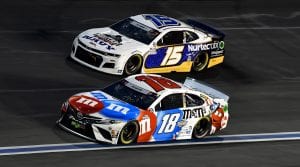CONCORD, N.C. — Though the box score might show a Coca-Cola 600 largely devoid of on-track action, Sunday’s race at Charlotte Motor Speedway was spiced up at times by one thing — lapped traffic.
While eventual winner Kyle Larson led 327 of 400 laps in the longest race on the NASCAR Cup Series schedule, those pursuing him — William Byron, Chase Elliott, Kyle Busch and others — were often left scrambling for position while closing rapidly on backmarkers that were well off the pace.
Cars such as David Starr’s No. 66 Toyota — which finished 31 laps down and whose best lap was a full 1.5 secondsslower than Larson’s was — and the Rick Ware Racing duo of Garrett Smithley and Josh Bilicki often led to pickpocket pass opportunities, even if they were harrowing due to a rapid closing rate.
Starr was the only driver called to pit road by NASCAR officials for failing to meet minimum speed, though what that specific threshold was Sunday night was never revealed by NASCAR officials.
Even still, the periodic chaos created by slower cars on the 1.5-mile track was a hot topic among the top-five finishers after the checkered flag waved on the 15th race of the season.
Often outspoken, Busch didn’t shy away from the subject after the Coca-Cola 600, but didn’t necessarily point fingers at anyone specifically. If anything, Busch played a diplomatic role.
“Some of it wasn’t so good, but others were fine,” said Busch, who finished third. “The problem was that [the track] was pretty much mainly one groove, right in the middle of the race track, and that’s where everybody wanted to be. That’s where the lapped cars wanted to be … and there were some inconsistencies as far as where they would go on the [corner] exits and whether they would go up to the wall or stay low and leave room [for the leaders].
“It was kind of a little bit of back-and-forth.”
Byron, who ended up fourth behind Busch, agreed with the two-time Cup Series champion’s summation that the slower cars created some issues for those challenging for top finishing positions.
“They were pretty bad,” Byron said. “I felt like, too, that lapped traffic was always running in the preferred lane … and I don’t know when that’s ever been the case. Usually, if the preferred lane is the bottom, then they [traffic] run the top … or whatever it is. It’s fine, most of them stayed in their lane.
“When you’re running the preferred lane, it makes it hard,” he added. “It’s not like my car was that much faster to where I could run in another lane [to make moves]. There wasn’t another lane on the track. I don’t really understand the thought process there. If I was running two or three laps down, I’d just kind of get out of the way.
“A lot of guys did well with it, but … it wasn’t like any of our cars were good enough to just motor by someone.”

Busch believed the issues with lapped traffic were partially caused by where and how the PJ1 traction compound was applied in the upper lanes of the corners, rendering the middle of the track as the fastest way around for most of the night.
“It definitely was a factor,” Busch tipped. “When you spray it the way they sprayed it, where it was sprayed and all that stuff, it made the track pretty one groovish and pretty dominant right in the middle. You could still move around a little bit, but whenever you would try to pass somebody that you were relatively the same speed as, you’d catch them and dive bomb to the bottom, but they would just stay in the gas in the traction compound and come right back on your outside.
“You can’t ever create any separation when you’re always in the gas, always in the throttle,” Busch added. “That’s a product of the car [and the aerodynamic package] as well too, not just the track.”
Building on some of the issues, Byron tipped that the 550-horsepower, high-downforce aerodynamic package highlights the speed differential between faster and slower cars much more than previous configurations.
“I feel like [the closing rate] has always been there, but with this package, the engineering just gets superior … and that’s where the speed difference comes from,” he explained.
As far as whether the minimum-speed rule deserves conversation and potential adjustment going forward, those who were in the thick of the action all night were hesitant to say one way or the other.
“I’m not the guy to make that call,” said fifth-place finisher Alex Bowman. “They can change it and I’ll keep racing, or they can leave it alone and I’ll keep racing. Either way, I’m going to drive the race car and get all I can get.”
“Probably,” Busch noted when directly asked if a change needed to be made. “I think I’ve said that for a long time, though, especially in this series.”
